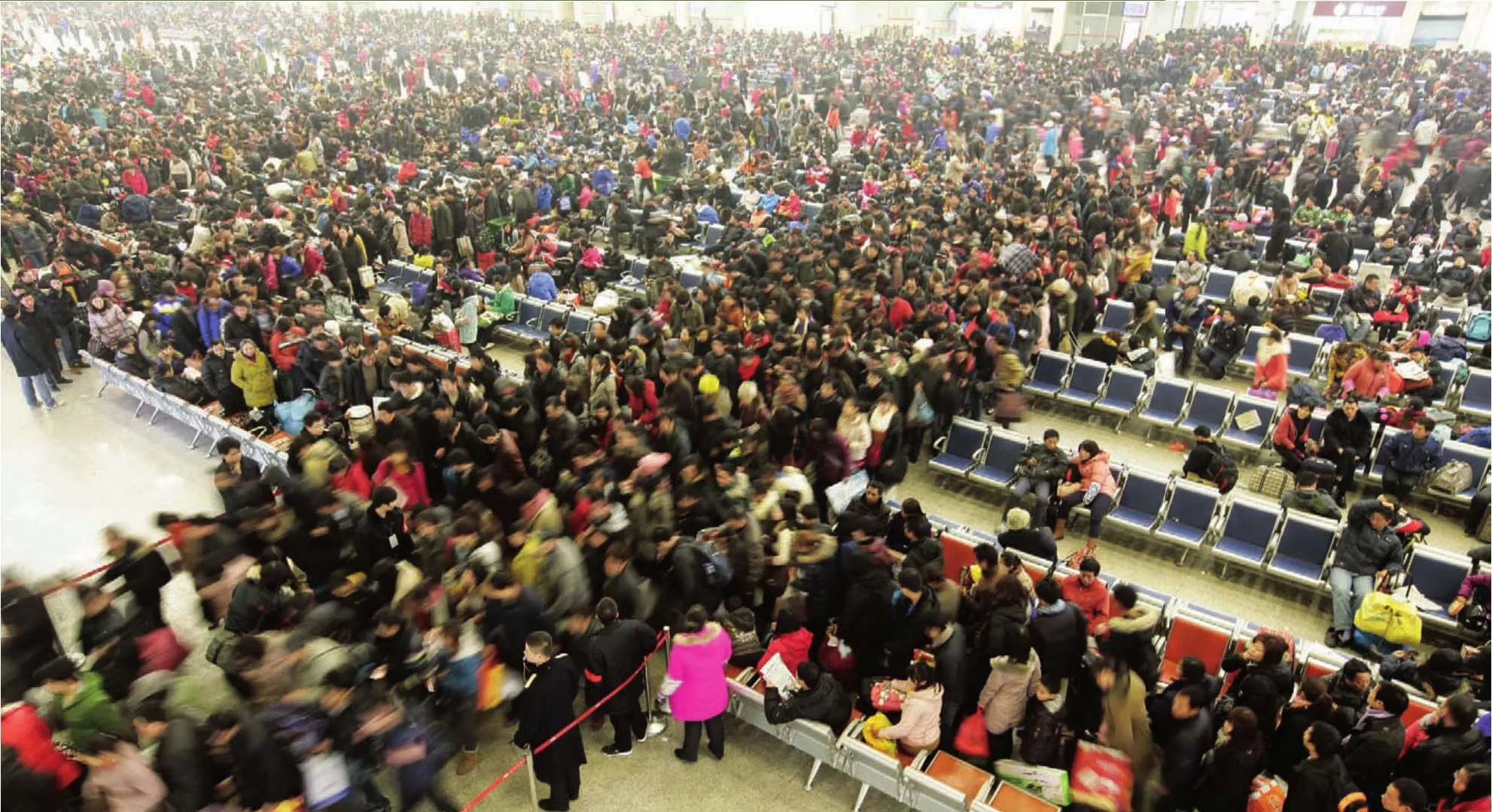Managing the Mass Migration
2012-10-16TransportationnetworkstrugglestocopewithSpringFestivaldemandByLanXinzhen
Transportation network struggles to cope with Spring Festival demand By Lan Xinzhen
Managing the Mass Migration
Transportation network struggles to cope with Spring Festival demand By Lan Xinzhen
Big crowds and foul air on the train,frighteningly long queues and fierce clashes at the station...these are common scenes during China’s Spring Festival travel rush. The annual travel peak is known as the world’s biggest human migration. This year’s stampede is still ongoing. Lasting over 40 days,people began returning to their hometowns on January 8 and the final stragglers will make their way back to the cities by February 16.
The railway is the major means of transportation during the period. Although its capacity to transport people has been strengthened by newly opened express routes,the situation for most passengers remained extremely dif fi cult.
“Although the railway’s transport capacity exceeded that of previous years, it still couldn’t meet the demand,” said Hu Yadong,Chinese Vice Minister of Railways.
“The difficulty in organizing transportation for the Spring Festival was in fact bigger than previous years as passenger fl ow surpassed transport capacity,” said Liu Tienan, Deputy Director of China’s National Development and Reform Commission (NDRC).
The Ministry of Railways (MOR) initiated a number of measures to deal with the seasonal surge in demand. It introduced telephone ticket booking and real-name online ticketing services to prevent ticket scalping. Additional temporary train services were also introduced to relieve the huge transport pressure.
However, these efforts failed to save the ministry from extensive criticism and accusations that it did not do enough to deal with passenger demand. Many travelers said they found it extremely dif fi cult to get tickets home for the Spring Festival and to return to work after the festival.
The ministry however claimed that it had used every single means at its disposal to increase transport capacity during the festival.
The average number of train departures hit 2,064 pairs a day, a record high for festival transportation and an increase of 131 journeys compared to the period before the festival.Some 5.88 million passengers were being conveyed per day. The ministry estimated the total number of train passengers would reach 235 million, an increase of 13.52 million,compared to the previous year.
Why is it so difficult?
The sheer number of people traveling during the festival has drawn considerable attention to the reasons behind the human stampede that takes place every year. Why do so many people choose to travel during the festival?
This is due to two realities in China. The fi rst is the imbalanced economic development between different regions. Many people from central and west China work in economically developed eastern coastal cities or major cities such as Beijing and Shanghai.
According to China’s National Bureau of Statistics, of Shenzhen’s total population of 14 million, 12 million are migrants; and of Beijing’s total population of about 20 million, more than 7 million are classi fi ed as fl oating. And this fl oating population mainly consists of migrant workers.
The other reality is the strict difference between having an agricultural and non-agricultural registered permanent residence in China. It is hard for migrant workers to register as permanent residents in the cities that they work in. Therefore millions of people work in cities, while their families remain in their hometowns.
Since the Spring Festival is the most important traditional holiday for the Chinese people, the vast majority of people choose to spend the festival with their families and are therefore prepared to travel home, regardless of the dif fi culties they face in terms of transport.
Thus a mass migration is formed. Shortly before the festival, a huge number of migrant workers travel to inner China from eastern coastal cities. Then after the festival, they go back to eastern coastal cities to make a living.
The huge traffic load is the result of so many people traveling within such a short period of time.
To meet the demand for transportation,China has greatly increased its investment in road and railway construction projects over the past few years. According to statistics released by the NDRC, in 2011, China added 11,000 km of expressways. In total, China now has 85,000 km of expressways, just behind the United States.
Along with the completion of a number of high-speed railway lines, such as the Beijing-Shanghai Express Railway, China now has over 3,000 km of high-speed rail track, more than any other country in the world.

PEAK TIME:Passengers wait in queues to get on the train at a railway station in Wuhan,capital city of central China’s Hubei Province, on January 15, 2012. The number of passengers hit a record high for the station
However, the increase in transport capacity,while sufficient to meet day-to-day demand, is insufficient to deal with the sharp spike in passenger numbers over the Spring Festival. Since the Spring Festival transportation program started in 1989, when migrant workers began to hunt for jobs in eastern coastal cities, the number of passengers during the festival has surged from 800 million to more than 3 billion.
Solutions
Spring Festival transportation has proved to be a stubborn problem. Some people have suggested solving the problem by enhancing the railway’s transport capacity. But the fact is China cannot construct its railways according to the demands of the Spring Festival, as that would lead to enormous waste and overcapacity on a day-to-day basis.
According to statistics from the MOR,normally Chinese railways only need to handle a daily passenger load of about 3 million.But during the Spring Festival, this number tops 5.8 million.
The second possible solution to the problem is to tackle the underlying causes behind the mass migration. Why do people travel so far from their hometowns to search for jobs?
“The major reason is the huge income gap between different regions,” said Su Hainan, Vice Chairman of the China Association for Labor.
There are some severe imbalances in China’s economic layout. In the eastern coastal cities, the development of secondary and tertiary industries has created numerous jobs. Job opportunities in inner China on the other hand remain quite limited, and salaries in those regions are signi fi cantly lower. As a result, a large number of workers have been attracted to more developed regions.
The income gap, both between urban and rural areas and between regions, is widening.This has contributed to an increase in the migrant population.
“The fundamental way to ease Spring Festival transport pressure is to promote balanced development between different regions through a more rational economic layout,” said Su.
“If the imbalance can’t be solved, passenger numbers won’t be reduced and transport pressure will remain the same,” said Su.
However, this sort of rebalancing can’t be achieved overnight. The Chinese Government has been striving to achieve more balanced development between different regions for several years.
Some encouraging results and tendencies are being reported. Labor-intensive, low value-added enterprises have begun to move to central and western regions. But the number of such businesses remains quite small and the income gap is still large.
“The best solution to the Spring Festival transport problem is to change the current system of registered permanent residence while striving for balanced regional development,”said Zhang Xiaode, an economics professor at the Chinese Academy of Governance.
“The social security discrimination behind the registered permanent residence system means that migrant workers lack a sense of belonging to the cities they work in,” said Zhang.
Faced with a number of problems including education, medical care and old age pensions, few migrant workers are willing and able to move their families to the city.
Zhang said that changing the registered permanent residence system would allow migrant workers’ families to join them in the cities, thus reducing the population fl ow during the Spring Festival.
“But this suggestion may not be approved as many of fi cials worry about the burden an in fl ux of migrant families would place on cities,” said Zhang.
“The process of absorbing migrant workers as urban citizens can be carried out little by little,” said Zhou Xiaozheng, a sociology professor at the Renmin University of China.
If cities can provide favorable policies for migrant workers that have worked in the city for more than fi ve years, offering them lowrent housing funded jointly by enterprises and the government, this would reduce the Spring Festival migration, said Zhou.
Zhou’s suggestion is just a temporary expedient. According to the NDRC, China’s urbanization rate will reach 65 percent by 2030.This means each year 20 million migrant workers become urban residents, and by 2030, about 400 million migrant workers and their families will have become urban citizens.
Zhou also suggested adopting flexible ticket prices to control passenger flows.For instance, one month before the Spring Festival transportation, tickets can be sold at a 20-percent discount. With the approach of the festival, prices would keep rising, reaching 110 percent of the original price. This would drive migrant workers to return to their hometowns as early as possible and thus ease some of the huge transport pressure.
